check engine HUMMER H3 2009 Owner's Manual
[x] Cancel search | Manufacturer: HUMMER, Model Year: 2009, Model line: H3, Model: HUMMER H3 2009Pages: 382, PDF Size: 1.99 MB
Page 241 of 382
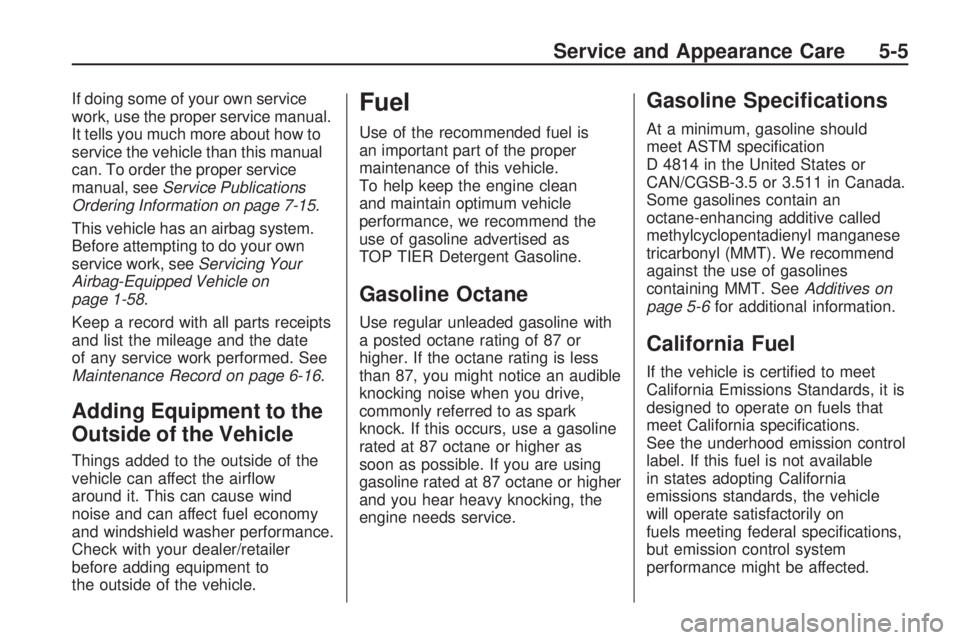
If doing some of your own service
work, use the proper service manual.
It tells you much more about how to
service the vehicle than this manual
can. To order the proper service
manual, seeService Publications
Ordering Information on page 7-15.
This vehicle has an airbag system.
Before attempting to do your own
service work, seeServicing Your
Airbag-Equipped Vehicle on
page 1-58.
Keep a record with all parts receipts
and list the mileage and the date
of any service work performed. See
Maintenance Record on page 6-16.
Adding Equipment to the
Outside of the Vehicle
Things added to the outside of the
vehicle can affect the air�ow
around it. This can cause wind
noise and can affect fuel economy
and windshield washer performance.
Check with your dealer/retailer
before adding equipment to
the outside of the vehicle.
Fuel
Use of the recommended fuel is
an important part of the proper
maintenance of this vehicle.
To help keep the engine clean
and maintain optimum vehicle
performance, we recommend the
use of gasoline advertised as
TOP TIER Detergent Gasoline.
Gasoline Octane
Use regular unleaded gasoline with
a posted octane rating of 87 or
higher. If the octane rating is less
than 87, you might notice an audible
knocking noise when you drive,
commonly referred to as spark
knock. If this occurs, use a gasoline
rated at 87 octane or higher as
soon as possible. If you are using
gasoline rated at 87 octane or higher
and you hear heavy knocking, the
engine needs service.
Gasoline Speci�cations
At a minimum, gasoline should
meet ASTM speci�cation
D 4814 in the United States or
CAN/CGSB-3.5 or 3.511 in Canada.
Some gasolines contain an
octane-enhancing additive called
methylcyclopentadienyl manganese
tricarbonyl (MMT). We recommend
against the use of gasolines
containing MMT. SeeAdditives on
page 5-6for additional information.
California Fuel
If the vehicle is certi�ed to meet
California Emissions Standards, it is
designed to operate on fuels that
meet California speci�cations.
See the underhood emission control
label. If this fuel is not available
in states adopting California
emissions standards, the vehicle
will operate satisfactorily on
fuels meeting federal speci�cations,
but emission control system
performance might be affected.
Service and Appearance Care 5-5
Page 242 of 382
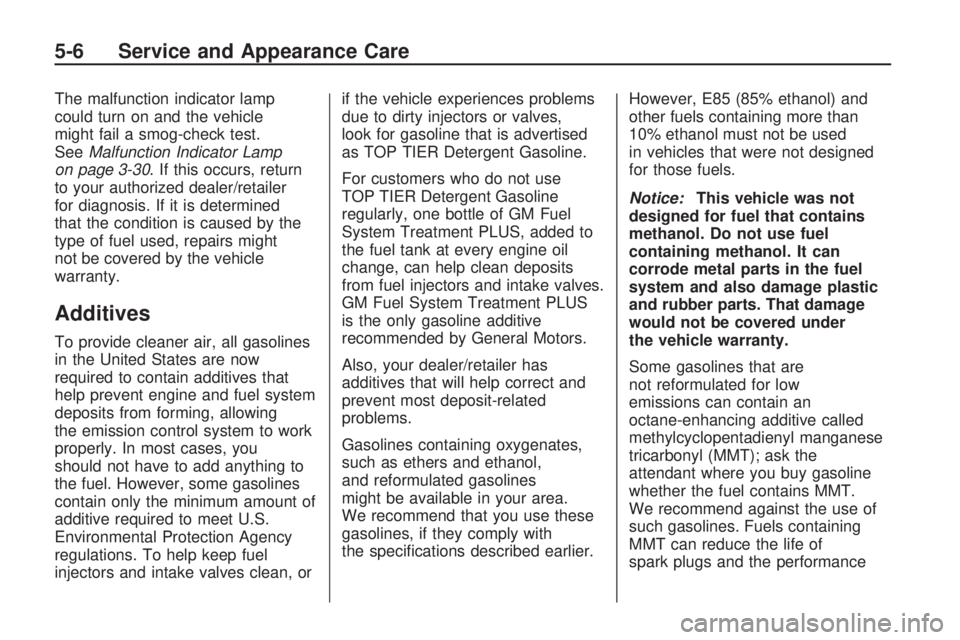
The malfunction indicator lamp
could turn on and the vehicle
might fail a smog-check test.
SeeMalfunction Indicator Lamp
on page 3-30. If this occurs, return
to your authorized dealer/retailer
for diagnosis. If it is determined
that the condition is caused by the
type of fuel used, repairs might
not be covered by the vehicle
warranty.
Additives
To provide cleaner air, all gasolines
in the United States are now
required to contain additives that
help prevent engine and fuel system
deposits from forming, allowing
the emission control system to work
properly. In most cases, you
should not have to add anything to
the fuel. However, some gasolines
contain only the minimum amount of
additive required to meet U.S.
Environmental Protection Agency
regulations. To help keep fuel
injectors and intake valves clean, orif the vehicle experiences problems
due to dirty injectors or valves,
look for gasoline that is advertised
as TOP TIER Detergent Gasoline.
For customers who do not use
TOP TIER Detergent Gasoline
regularly, one bottle of GM Fuel
System Treatment PLUS, added to
the fuel tank at every engine oil
change, can help clean deposits
from fuel injectors and intake valves.
GM Fuel System Treatment PLUS
is the only gasoline additive
recommended by General Motors.
Also, your dealer/retailer has
additives that will help correct and
prevent most deposit-related
problems.
Gasolines containing oxygenates,
such as ethers and ethanol,
and reformulated gasolines
might be available in your area.
We recommend that you use these
gasolines, if they comply with
the speci�cations described earlier.However, E85 (85% ethanol) and
other fuels containing more than
10% ethanol must not be used
in vehicles that were not designed
for those fuels.
Notice:This vehicle was not
designed for fuel that contains
methanol. Do not use fuel
containing methanol. It can
corrode metal parts in the fuel
system and also damage plastic
and rubber parts. That damage
would not be covered under
the vehicle warranty.
Some gasolines that are
not reformulated for low
emissions can contain an
octane-enhancing additive called
methylcyclopentadienyl manganese
tricarbonyl (MMT); ask the
attendant where you buy gasoline
whether the fuel contains MMT.
We recommend against the use of
such gasolines. Fuels containing
MMT can reduce the life of
spark plugs and the performance
5-6 Service and Appearance Care
Page 243 of 382
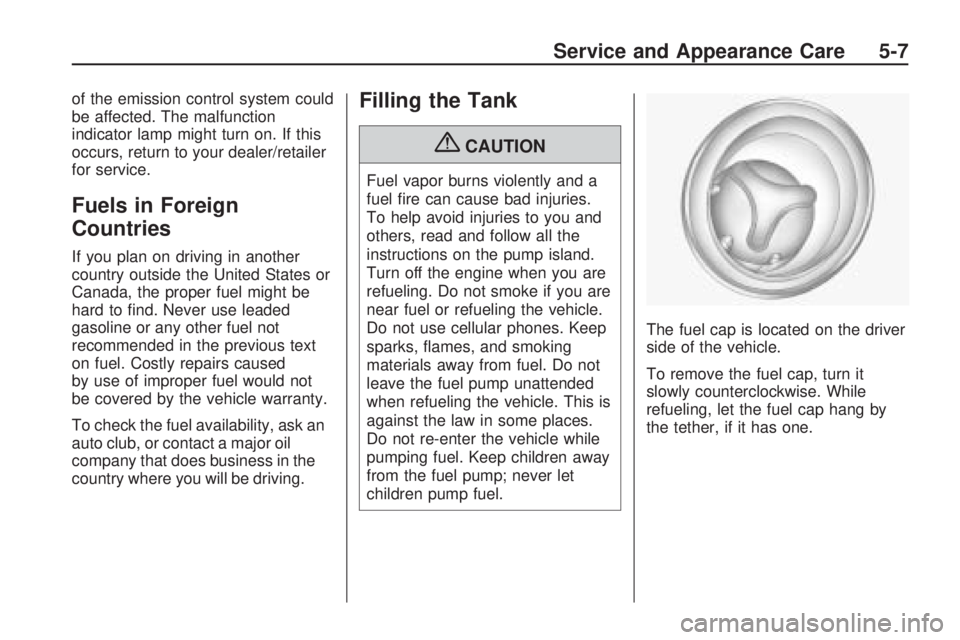
of the emission control system could
be affected. The malfunction
indicator lamp might turn on. If this
occurs, return to your dealer/retailer
for service.
Fuels in Foreign
Countries
If you plan on driving in another
country outside the United States or
Canada, the proper fuel might be
hard to �nd. Never use leaded
gasoline or any other fuel not
recommended in the previous text
on fuel. Costly repairs caused
by use of improper fuel would not
be covered by the vehicle warranty.
To check the fuel availability, ask an
auto club, or contact a major oil
company that does business in the
country where you will be driving.
Filling the Tank
{CAUTION
Fuel vapor burns violently and a
fuel �re can cause bad injuries.
To help avoid injuries to you and
others, read and follow all the
instructions on the pump island.
Turn off the engine when you are
refueling. Do not smoke if you are
near fuel or refueling the vehicle.
Do not use cellular phones. Keep
sparks, �ames, and smoking
materials away from fuel. Do not
leave the fuel pump unattended
when refueling the vehicle. This is
against the law in some places.
Do not re-enter the vehicle while
pumping fuel. Keep children away
from the fuel pump; never let
children pump fuel.The fuel cap is located on the driver
side of the vehicle.
To remove the fuel cap, turn it
slowly counterclockwise. While
refueling, let the fuel cap hang by
the tether, if it has one.
Service and Appearance Care 5-7
Page 245 of 382
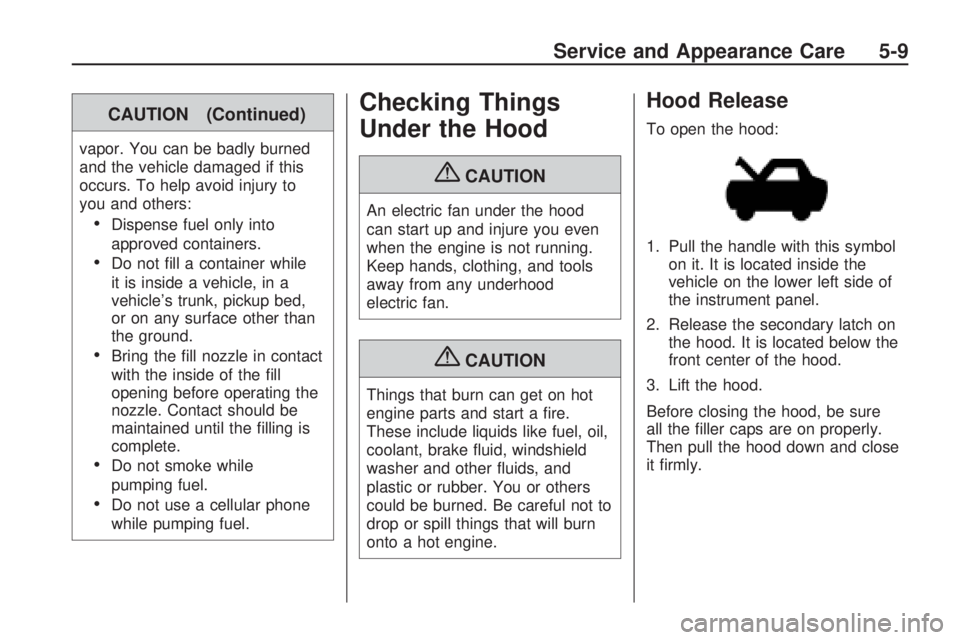
CAUTION (Continued)
vapor. You can be badly burned
and the vehicle damaged if this
occurs. To help avoid injury to
you and others:
Dispense fuel only into
approved containers.
Do not �ll a container while
it is inside a vehicle, in a
vehicle’s trunk, pickup bed,
or on any surface other than
the ground.
Bring the �ll nozzle in contact
with the inside of the �ll
opening before operating the
nozzle. Contact should be
maintained until the �lling is
complete.
Do not smoke while
pumping fuel.
Do not use a cellular phone
while pumping fuel.
Checking Things
Under the Hood
{CAUTION
An electric fan under the hood
can start up and injure you even
when the engine is not running.
Keep hands, clothing, and tools
away from any underhood
electric fan.
{CAUTION
Things that burn can get on hot
engine parts and start a �re.
These include liquids like fuel, oil,
coolant, brake �uid, windshield
washer and other �uids, and
plastic or rubber. You or others
could be burned. Be careful not to
drop or spill things that will burn
onto a hot engine.
Hood Release
To open the hood:
1. Pull the handle with this symbol
on it. It is located inside the
vehicle on the lower left side of
the instrument panel.
2. Release the secondary latch on
the hood. It is located below the
front center of the hood.
3. Lift the hood.
Before closing the hood, be sure
all the �ller caps are on properly.
Then pull the hood down and close
it �rmly.
Service and Appearance Care 5-9
Page 247 of 382
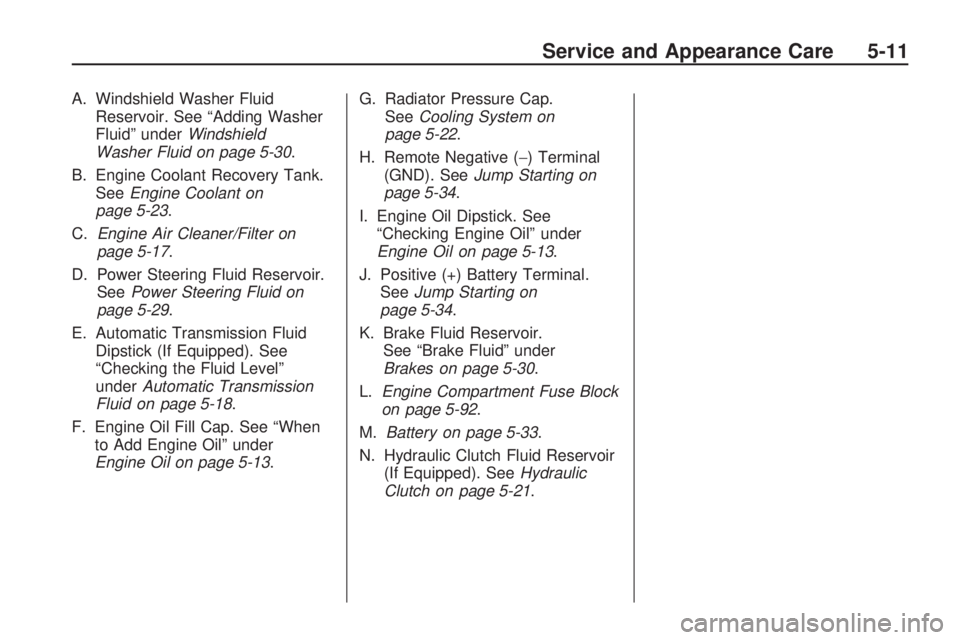
A. Windshield Washer Fluid
Reservoir. See “Adding Washer
Fluid” underWindshield
Washer Fluid on page 5-30.
B. Engine Coolant Recovery Tank.
SeeEngine Coolant on
page 5-23.
C.Engine Air Cleaner/Filter on
page 5-17.
D. Power Steering Fluid Reservoir.
SeePower Steering Fluid on
page 5-29.
E. Automatic Transmission Fluid
Dipstick (If Equipped). See
“Checking the Fluid Level”
underAutomatic Transmission
Fluid on page 5-18.
F. Engine Oil Fill Cap. See “When
to Add Engine Oil” under
Engine Oil on page 5-13.G. Radiator Pressure Cap.
SeeCooling System on
page 5-22.
H. Remote Negative (−) Terminal
(GND). SeeJump Starting on
page 5-34.
I. Engine Oil Dipstick. See
“Checking Engine Oil” under
Engine Oil on page 5-13.
J. Positive (+) Battery Terminal.
SeeJump Starting on
page 5-34.
K. Brake Fluid Reservoir.
See “Brake Fluid” under
Brakes on page 5-30.
L.Engine Compartment Fuse Block
on page 5-92.
M.Battery on page 5-33.
N. Hydraulic Clutch Fluid Reservoir
(If Equipped). SeeHydraulic
Clutch on page 5-21.
Service and Appearance Care 5-11
Page 249 of 382
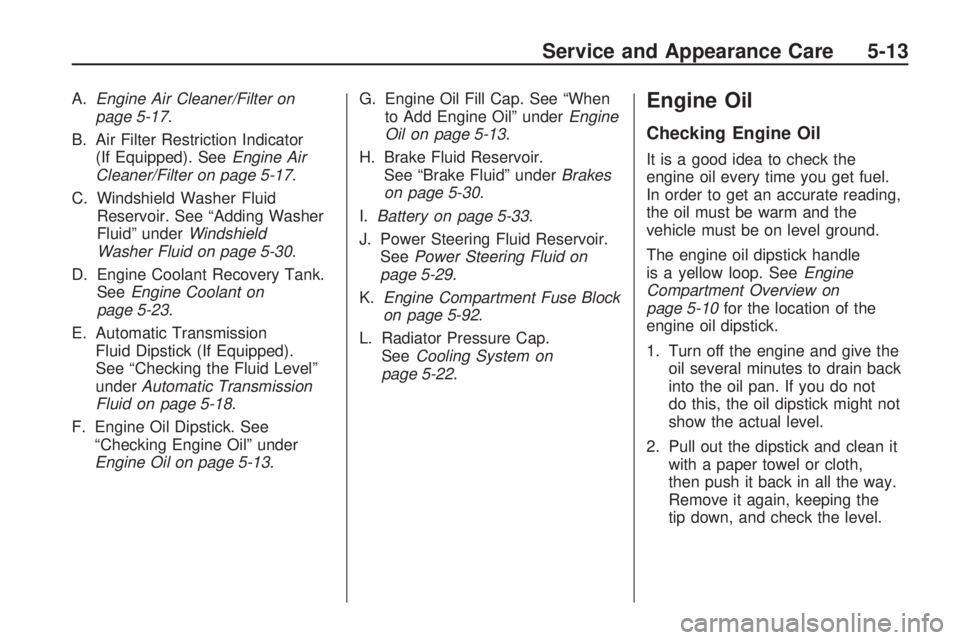
A.Engine Air Cleaner/Filter on
page 5-17.
B. Air Filter Restriction Indicator
(If Equipped). SeeEngine Air
Cleaner/Filter on page 5-17.
C. Windshield Washer Fluid
Reservoir. See “Adding Washer
Fluid” underWindshield
Washer Fluid on page 5-30.
D. Engine Coolant Recovery Tank.
SeeEngine Coolant on
page 5-23.
E. Automatic Transmission
Fluid Dipstick (If Equipped).
See “Checking the Fluid Level”
underAutomatic Transmission
Fluid on page 5-18.
F. Engine Oil Dipstick. See
“Checking Engine Oil” under
Engine Oil on page 5-13.G. Engine Oil Fill Cap. See “When
to Add Engine Oil” underEngine
Oil on page 5-13.
H. Brake Fluid Reservoir.
See “Brake Fluid” underBrakes
on page 5-30.
I.Battery on page 5-33.
J. Power Steering Fluid Reservoir.
SeePower Steering Fluid on
page 5-29.
K.Engine Compartment Fuse Block
on page 5-92.
L. Radiator Pressure Cap.
SeeCooling System on
page 5-22.Engine Oil
Checking Engine Oil
It is a good idea to check the
engine oil every time you get fuel.
In order to get an accurate reading,
the oil must be warm and the
vehicle must be on level ground.
The engine oil dipstick handle
is a yellow loop. SeeEngine
Compartment Overview on
page 5-10for the location of the
engine oil dipstick.
1. Turn off the engine and give the
oil several minutes to drain back
into the oil pan. If you do not
do this, the oil dipstick might not
show the actual level.
2. Pull out the dipstick and clean it
with a paper towel or cloth,
then push it back in all the way.
Remove it again, keeping the
tip down, and check the level.
Service and Appearance Care 5-13
Page 252 of 382
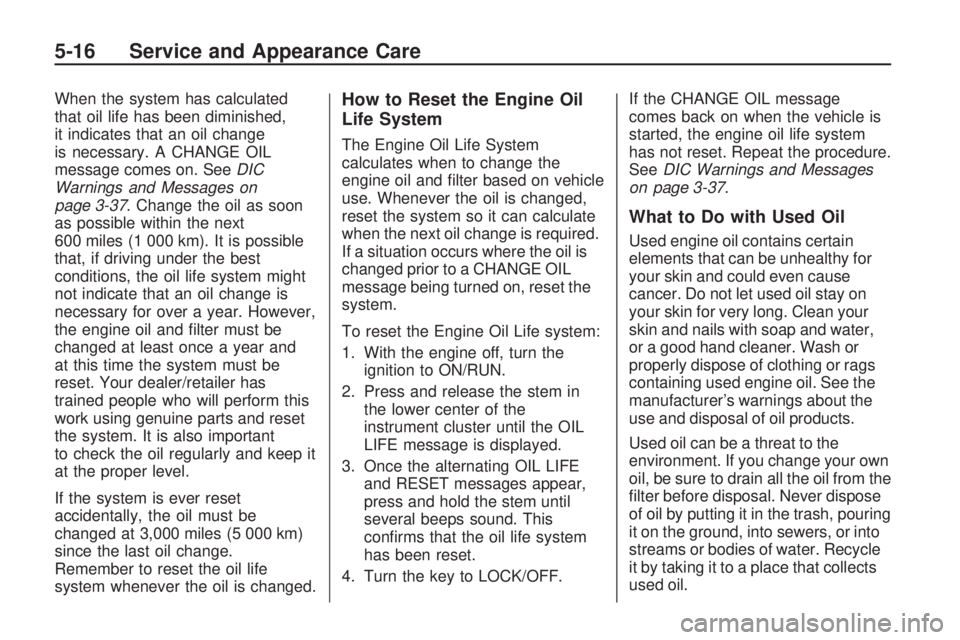
When the system has calculated
that oil life has been diminished,
it indicates that an oil change
is necessary. A CHANGE OIL
message comes on. SeeDIC
Warnings and Messages on
page 3-37. Change the oil as soon
as possible within the next
600 miles (1 000 km). It is possible
that, if driving under the best
conditions, the oil life system might
not indicate that an oil change is
necessary for over a year. However,
the engine oil and �lter must be
changed at least once a year and
at this time the system must be
reset. Your dealer/retailer has
trained people who will perform this
work using genuine parts and reset
the system. It is also important
to check the oil regularly and keep it
at the proper level.
If the system is ever reset
accidentally, the oil must be
changed at 3,000 miles (5 000 km)
since the last oil change.
Remember to reset the oil life
system whenever the oil is changed.How to Reset the Engine Oil
Life System
The Engine Oil Life System
calculates when to change the
engine oil and �lter based on vehicle
use. Whenever the oil is changed,
reset the system so it can calculate
when the next oil change is required.
If a situation occurs where the oil is
changed prior to a CHANGE OIL
message being turned on, reset the
system.
To reset the Engine Oil Life system:
1. With the engine off, turn the
ignition to ON/RUN.
2. Press and release the stem in
the lower center of the
instrument cluster until the OIL
LIFE message is displayed.
3. Once the alternating OIL LIFE
and RESET messages appear,
press and hold the stem until
several beeps sound. This
con�rms that the oil life system
has been reset.
4. Turn the key to LOCK/OFF.If the CHANGE OIL message
comes back on when the vehicle is
started, the engine oil life system
has not reset. Repeat the procedure.
SeeDIC Warnings and Messages
on page 3-37.
What to Do with Used Oil
Used engine oil contains certain
elements that can be unhealthy for
your skin and could even cause
cancer. Do not let used oil stay on
your skin for very long. Clean your
skin and nails with soap and water,
or a good hand cleaner. Wash or
properly dispose of clothing or rags
containing used engine oil. See the
manufacturer’s warnings about the
use and disposal of oil products.
Used oil can be a threat to the
environment. If you change your own
oil, be sure to drain all the oil from the
�lter before disposal. Never dispose
of oil by putting it in the trash, pouring
it on the ground, into sewers, or into
streams or bodies of water. Recycle
it by taking it to a place that collects
used oil.
5-16 Service and Appearance Care
Page 254 of 382

Automatic Transmission
Fluid
When to Check and Change
Automatic Transmission Fluid
A good time to check the automatic
transmission �uid level is when
the engine oil is changed.
Change the �uid and �lter at the
intervals listed inAdditional
Required Services on page 6-6, and
be sure to use the transmission
�uid listed inRecommended Fluids
and Lubricants on page 6-12.
How to Check Automatic
Transmission Fluid
Because this operation can be a
little difficult, you may choose
to have this done at the
dealer/retailer service department.
If adding it yourself, be sure to follow
all the instructions here, or there
could be a false reading on the
dipstick.Notice:Too much or too little
�uid can damage your
transmission. Too much can
mean that some of the �uid could
come out and fall on hot engine
parts or exhaust system parts,
starting a �re. Too little �uid
could cause the transmission to
overheat. Be sure to get an
accurate reading if you check
your transmission �uid.
Wait at least 30 minutes before
checking the transmission �uid level
if you have been driving:
When outside temperatures are
above 90°F (32°C).
At high speed for quite a while.
In heavy traffic — especially
in hot weather.
While pulling a trailer.
To get the right reading, the �uid
should be at normal operating
temperature, which is 180°F to
200°F (82°C to 93°C).Get the vehicle warmed up by
driving about 15 miles (24 km) when
outside temperatures are above
50°F (10°C). If it is colder than
50°F (10°C), drive the vehicle
in 3 (Third) until the engine
temperature gage moves and then
remains steady for 10 minutes.
A cold �uid check can be made after
the vehicle has been sitting for
eight hours or more with the engine
off, but this is used only as a
reference. Let the engine run at
idle for �ve minutes if outside
temperatures are 50°F (10°C) or
more. If it is colder than 50°F (10°C),
the engine might have to idle
longer. Should the �uid level
be low during this cold check,
check the �uid hot before adding
�uid. Checking the �uid hot gives
a more accurate reading of the
�uid level.
5-18 Service and Appearance Care
Page 255 of 382

Checking the Fluid Level
To prepare the vehicle:
1. Park the vehicle on a level place.
Keep the engine running.
2. With the parking brake applied,
place the shift lever in P (Park).
3. With your foot on the brake
pedal, move the shift lever
through each gear range,
pausing for about three seconds
in each range. Then, position
the shift lever in P (Park).
4. Let the engine run at idle for
three minutes or more.
Then, without shutting off the
engine:
1. Flip the handle up and then pull
out the dipstick and wipe it with
a clean rag or paper towel.The automatic transmission
dipstick handle with this symbol
on it is located in the engine
compartment on the passenger
side of the vehicle.
SeeEngine Compartment
Overview on page 5-10for more
information on location.
2. Push it back in all the way, wait
three seconds, and pull it back
out again.
3. Check both sides of the dipstick,
and read the lower level.
The �uid level must be in
the COLD area, below thecross-hatched area, for a
cold check or in the HOT or
cross-hatched area for a
hot check. Be sure to keep the
dipstick pointed down to get
an accurate reading.
4. If the �uid level is in the
acceptable range, push
the dipstick back in all the way;
then �ip the handle down to
lock the dipstick in place.
How to Add Automatic
Transmission Fluid
Refer to the Maintenance
Schedule to determine what kind
of transmission �uid to use.
SeeRecommended Fluids and
Lubricants on page 6-12.
Add �uid only after checking the
transmission �uid while it is hot.
A cold check is used only as
a reference. If the �uid level is low,
add only enough of the proper
�uid to bring the level up to the
HOT area for a hot check.
Service and Appearance Care 5-19
Page 256 of 382
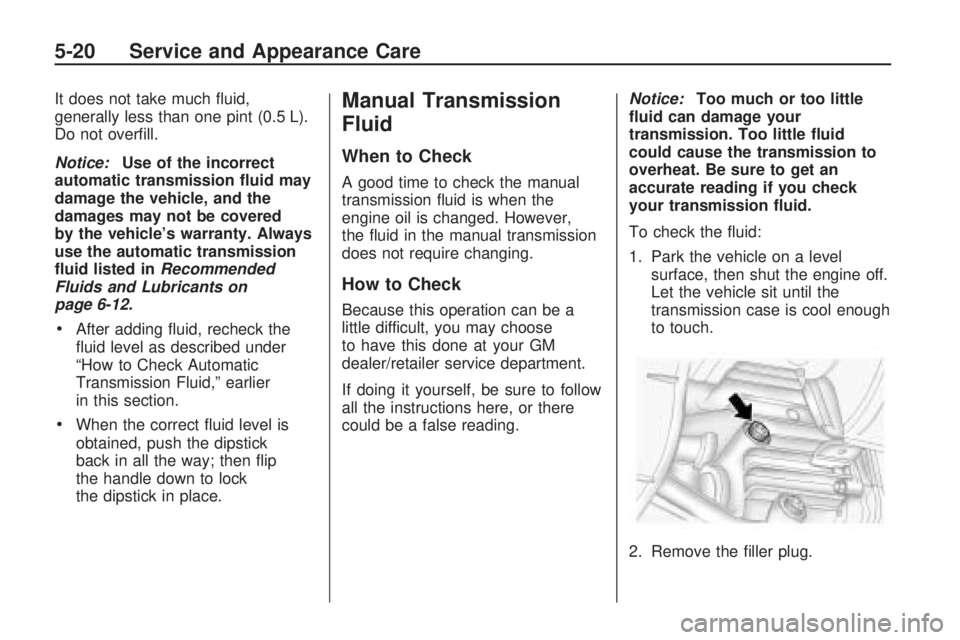
It does not take much �uid,
generally less than one pint (0.5 L).
Do not over�ll.
Notice:Use of the incorrect
automatic transmission �uid may
damage the vehicle, and the
damages may not be covered
by the vehicle’s warranty. Always
use the automatic transmission
�uid listed inRecommended
Fluids and Lubricants on
page 6-12.
After adding �uid, recheck the
�uid level as described under
“How to Check Automatic
Transmission Fluid,” earlier
in this section.
When the correct �uid level is
obtained, push the dipstick
back in all the way; then �ip
the handle down to lock
the dipstick in place.
Manual Transmission
Fluid
When to Check
A good time to check the manual
transmission �uid is when the
engine oil is changed. However,
the �uid in the manual transmission
does not require changing.
How to Check
Because this operation can be a
little difficult, you may choose
to have this done at your GM
dealer/retailer service department.
If doing it yourself, be sure to follow
all the instructions here, or there
could be a false reading.Notice:Too much or too little
�uid can damage your
transmission. Too little �uid
could cause the transmission to
overheat. Be sure to get an
accurate reading if you check
your transmission �uid.
To check the �uid:
1. Park the vehicle on a level
surface, then shut the engine off.
Let the vehicle sit until the
transmission case is cool enough
to touch.
2. Remove the �ller plug.
5-20 Service and Appearance Care